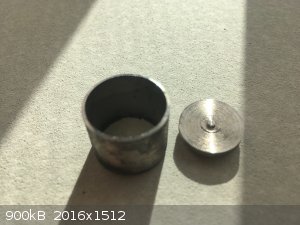| Pages:
1
2 |
macckone
Dispenser of practical lab wisdom
    
Posts: 2168
Registered: 1-3-2013
Location: Over a mile high
Member Is Offline
Mood: Electrical
|
|
At 500C you should have only nitriding with little carbon absorption from the sources I have read.
Nitriding is only a couple of mils deep in most cases again from what I have read.
It sounds like it worked which is rather cool. Now there is a use for the millions of tubes of hardened super glue sitting in everyone's houses.
|
|
|
markx
National Hazard
   
Posts: 646
Registered: 7-8-2003
Location: Northern kingdom
Member Is Offline
Mood: Very Jolly
|
|

Fig.1 The test bodies pre cyanoacrylate treatment
Two sections of mild steel pipe (only one is used in experiment) and a disc of high strength threaded rod center section with the tread machined off.
I do not know the exact compositions of the alloys, but the mild steel pipe I trust is mostly iron with less than 0,3% carbon as it is not heat
treatable. The high strength threaded rod is definately a high carbon alloy judging by spark test and it definately also contains alloying elements of
carbide forming nature (most possibly chromium). It is one of the least machinable steels that I have encountered. It just eats cutting tools....tool
steel and carbide alike. It also work hardens to the degree where even honed carbide is unable to touch the surface once it has been hardened by a
dulled tool skidding over the workpiece.

Fig.2 A view into the sodium carbonate filled reaction vessel after 2h in 500C furnace. The cyanoacrylate encrusted samples are buried in the depth of
the vessel.
 
Fig 3. The samples after the supposed nitrocarburizing treatment. Both look very little affected by visual assessment.
The samples were "scratch tested" with file and showed a slightly increased surface hardness to pre treatment condition. It was still possible to cut
both with a file, but a very thin hard surface layer was covering them (supposedly nitride bearing layer).
The mild steel pipe was spark tested and showed a definite high carbon signature. Unless nitrogen inclusion produces the same spark (not that I know
of) then there must have been some carbon migration into the samples even under these mild conditions.
The mild steel sample was also subjected to a water quench from around 850C after which the surface of the sample hardened to a degree where it was no
longer possible to cut into it with a metal file (most probably a carbon case?).
The high carbon steel sample was not subjected to additional heat treatments as i would not have shown any recognizable effects (it was highly water
hardenable already in the pre nitrocarburizing state).
Exact science is a figment of imagination.......
|
|
|
macckone
Dispenser of practical lab wisdom
    
Posts: 2168
Registered: 1-3-2013
Location: Over a mile high
Member Is Offline
Mood: Electrical
|
|
This is really cool work. Obviously ammonia nitriding would be more reliable than this if you could work with ammonia gas. But the fact that you do
get nitriding with the methylcyanoacrylate is cool.
|
|
|
tocnaza
Harmless

Posts: 1
Registered: 2-10-2018
Member Is Offline
|
|
Very interesting, thanks for sharing!
|
|
|
markx
National Hazard
   
Posts: 646
Registered: 7-8-2003
Location: Northern kingdom
Member Is Offline
Mood: Very Jolly
|
|
Quote: Originally posted by macckone  | | This is really cool work. Obviously ammonia nitriding would be more reliable than this if you could work with ammonia gas. But the fact that you do
get nitriding with the methylcyanoacrylate is cool. |
Thanks for the kind words! 
I'm not totally sure that I get a nitriding action here....it looks more like a carbon enrichment type of process is mostly happening. With perhaps a
very slight nitriding because the surface layer of the samples was harder than before the treatment. It is still not nearly comparable to the boriding
treatment...that case was epic in it's pure hardness.
I think the main cause for the weak nitriding action is that the gaseous reactants just escape the vessel too quickly and not much interaction occurs.
I'm not inclined to use a closed vessel for the process and create a possible rupture in the furnace spilling cyanide gas into the lab. I trust my
lab assistant would not hesitate to cast me into concrete for that kind of a stunt  
Exact science is a figment of imagination.......
|
|
|
rolynd
Harmless

Posts: 16
Registered: 13-12-2004
Location: At Home
Member Is Offline
Mood: No Mood
|
|
According to the vid description this guy is using a mixture of
45g urea
40g potash
10g sodium hydroxide
10g salt
at a temp of 580°c for 1h
https://youtu.be/g91tC6n7jTw
[Edited on 14-10-2018 by rolynd]
|
|
|
Fulmen
International Hazard
    
Posts: 1720
Registered: 24-9-2005
Member Is Offline
Mood: Bored
|
|
This should create sodium cyanate, making it a fairly standard nitrocarburization-bath.
We're not banging rocks together here. We know how to put a man back together.
|
|
|
Texium
|
Thread Moved
27-11-2023 at 12:33 |
| Pages:
1
2 |